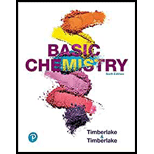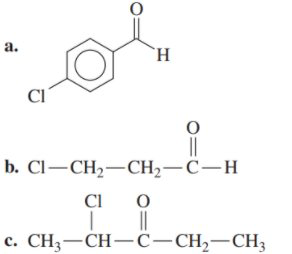
EBK BASIC CHEMISTRY
6th Edition
ISBN: 9780134987088
Author: Timberlake
Publisher: PEARSON CO
expand_more
expand_more
format_list_bulleted
Textbook Question
Chapter 17, Problem 95APP
Write the IUPAC name for each of the following: (17.5)

Expert Solution & Answer
Want to see the full answer?
Check out a sample textbook solution
Students have asked these similar questions
03 Question (1 point)
For the reaction below, draw both of the major organic products. Be sure to consider stereochemistry.
>
1. CH₂CH₂MgBr
2. H₂O
3rd attempt
Draw all four bonds at chiral centers. Draw all stereoisomers formed.
Draw the structures here.
e
130
AN
H
See Periodic Table See Hint
P
C
Br
You may wish to address the following issues in your response if they are pertinent to the reaction(s) you propose to employ:1) Chemoselectivity (why this functional group and not another?)
2) Regioselectivity (why here and not there?)
3) Stereoselectivity (why this stereoisomer?)
4) Changes in oxidation state.
Please make it in detail and draw it out too in what step what happens. Thank you for helping me!
1) Chemoselectivity (why this functional group and not another?)
2) Regioselectivity (why here and not there?)
3) Stereoselectivity (why this stereoisomer?)
4) Changes in oxidation state.
Everything in detail and draw out and write it.
Chapter 17 Solutions
EBK BASIC CHEMISTRY
Ch. 17.1 - Prob. 1PPCh. 17.1 - Prob. 2PPCh. 17.1 - Prob. 3PPCh. 17.1 - Prob. 4PPCh. 17.1 - Prob. 5PPCh. 17.1 - Prob. 6PPCh. 17.1 - Prob. 7PPCh. 17.1 - Prob. 8PPCh. 17.1 - Prob. 9PPCh. 17.1 - Prob. 10PP
Ch. 17.1 - Prob. 11PPCh. 17.1 - Draw the condensed structural formula for each of...Ch. 17.1 - Prob. 13PPCh. 17.1 - Prob. 14PPCh. 17.1 - Prob. 15PPCh. 17.1 - Prob. 16PPCh. 17.1 - Prob. 17PPCh. 17.1 - Prob. 18PPCh. 17.2 - Prob. 19PPCh. 17.2 - Identify each of the following as an alkane,...Ch. 17.2 - Prob. 21PPCh. 17.2 - Prob. 22PPCh. 17.2 - Prob. 23PPCh. 17.2 - Prob. 24PPCh. 17.2 - Draw the condensed structural formula for the...Ch. 17.2 - Prob. 26PPCh. 17.2 - Prob. 27PPCh. 17.2 - Prob. 28PPCh. 17.2 - Prob. 29PPCh. 17.2 - Prob. 30PPCh. 17.2 - Prob. 31PPCh. 17.2 - Prob. 32PPCh. 17.3 - Prob. 33PPCh. 17.3 - Prob. 34PPCh. 17.3 - Prob. 35PPCh. 17.3 - Draw the line-angle formula for each of the...Ch. 17.4 - Prob. 37PPCh. 17.4 - Prob. 38PPCh. 17.4 - Prob. 39PPCh. 17.4 - Write the common name for each of the following:...Ch. 17.4 - Draw the condensed structural and line-angle...Ch. 17.4 - Draw the condensed structural and line-angle...Ch. 17.5 - Write the common name for each of the following:Ch. 17.5 - Write the common name for each of the following:Ch. 17.5 - Prob. 45PPCh. 17.5 - Prob. 46PPCh. 17.5 - Prob. 47PPCh. 17.5 - Draw the condensed structural formula for a and b...Ch. 17.6 - Prob. 49PPCh. 17.6 - Write the IUPAC and common name (if any) for each...Ch. 17.6 - Prob. 51PPCh. 17.6 - Prob. 52PPCh. 17.6 - Prob. 53PPCh. 17.6 - Prob. 54PPCh. 17.6 - Prob. 55PPCh. 17.6 - Prob. 56PPCh. 17.6 - Prob. 57PPCh. 17.6 - Write the IUPAC and common names, if any, for each...Ch. 17.6 - Draw the condensed structural formulas for a and b...Ch. 17.6 - Draw the condensed structural formulas for a and b...Ch. 17.7 - Write the common name for each of the following:...Ch. 17.7 - Prob. 62PPCh. 17.7 - Prob. 63PPCh. 17.7 - Prob. 64PPCh. 17.7 - Prob. 65PPCh. 17.7 - Prob. 66PPCh. 17.7 - Prob. 67PPCh. 17.7 - Prob. 68PPCh. 17.7 - Prob. 69PPCh. 17.7 - Prob. 70PPCh. 17.7 - Prob. 71PPCh. 17.7 - Prob. 72PPCh. 17 - The chapter sections to review are shown in...Ch. 17 - The chapter sections to review are shown in...Ch. 17 - Prob. 75UTCCh. 17 - Prob. 76UTCCh. 17 - Prob. 77APPCh. 17 - Prob. 78APPCh. 17 - Prob. 79APPCh. 17 - Prob. 80APPCh. 17 - Prob. 81APPCh. 17 - Prob. 82APPCh. 17 - Prob. 83APPCh. 17 - Prob. 84APPCh. 17 - Classify each of the following according to its...Ch. 17 - Classify each of the following according to its...Ch. 17 - Name each of the following aromatic compounds:...Ch. 17 - Prob. 88APPCh. 17 - Prob. 89APPCh. 17 - Draw the structural formula for each of the...Ch. 17 - Prob. 91APPCh. 17 - Prob. 92APPCh. 17 - Draw the condensed structural formula for each of...Ch. 17 - Draw the condensed structural formula for each of...Ch. 17 - Write the IUPAC name for each of the following:...Ch. 17 - Write the IUPAC name for each of the following:...Ch. 17 - Draw the condensed structural formulas for a and b...Ch. 17 - Prob. 98APPCh. 17 - Prob. 99APPCh. 17 - Prob. 100APPCh. 17 - Prob. 101APPCh. 17 - Draw the condensed structural formula for each of...Ch. 17 - Prob. 103APPCh. 17 - Prob. 104APPCh. 17 - Prob. 105CPCh. 17 - Prob. 106CPCh. 17 - The following problems are related to the topics...Ch. 17 - Prob. 108CPCh. 17 - The following problems are related to the topics...Ch. 17 - Prob. 110CP
Knowledge Booster
Learn more about
Need a deep-dive on the concept behind this application? Look no further. Learn more about this topic, chemistry and related others by exploring similar questions and additional content below.Similar questions
- Calculating the pH at equivalence of a titration 3/5 Izabella A chemist titrates 120.0 mL of a 0.7191M dimethylamine ((CH3)2NH) solution with 0.5501 M HBr solution at 25 °C. Calculate the pH at equivalence. The pk of dimethylamine is 3.27. Round your answer to 2 decimal places. Note for advanced students: you may assume the total volume of the solution equals the initial volume plus the volume of HBr solution added. pH = ☐ ✓ 18 Ar Boarrow_forwardAlcohols can be synthesized using an acid-catalyzed hydration of an alkene. An alkene is combined with aqueous acid (e.. sulfuric acid in water). The reaction mechanism typically involves a carbocation intermediate. > 3rd attempt 3343 10 8 Draw arrows to show the reaction between the alkene and hydronium ion. that 2nd attempt Feedback 1st attempt تعمال Ju See Periodic Table See Hint F D Ju See Periodic Table See Hintarrow_forwardDraw the simplified curved arrow mechanism for the reaction of acetone and CHgLi to give the major product. 4th attempt Π Draw the simplified curved arrow mechanism T 3rd attempt Feedback Ju See Periodic Table See Hint H -H H -I H F See Periodic Table See Hintarrow_forward
- Select the correct reagent to accomplish the first step of this reaction. Then draw a mechanism on the Grignard reagent using curved arrow notation to show how it is converted to the final product. 4th attempt Part 1 (0.5 point) Select the correct reagent to accomplish the first step of this reaction. Choose one: OA Mg in ethanol (EtOH) OB. 2 Li in THF O C. Li in THF D. Mg in THF O E Mg in H2O Part 2 (0.5 point) Br Part 1 Bri Mg CH B CH, 1 Draw intermediate here, but no arrows. © TE See Periodic Table See Hint See Hint ין Harrow_forwardSelect the product for the following reaction. HO HO PCC OH ○ OH O HO ○ HO HO HOarrow_forward5:45 Х Select the final product for the following reaction sequence. O O 1. Mg. ether 2.D.Oarrow_forward
- Based on the chart Two similarities between the molecule with alpha glycosidic linkages. Two similarities between the molecules with beta glycosidtic linkages. Two differences between the alpha and beta glycosidic linkages.arrow_forwardplease help fill in the tablearrow_forwardAnswer F pleasearrow_forward
- 4. Refer to the data below to answer the following questions: The octapeptide saralasin is a specific antagonist of angiotensin II. A derivative of saralasin is used therapeutically as an antihypertensive. Amino acid analysis of saralasin show the presence of the following amino acids: Ala, Arg, His, Pro, Sar, Tyr, Val, Val A.Sar is the abbreviation for sarcosine, N-methyl aminoethanoic acid. Draw the structure of sarcosine. B. N-Terminal analysis by the Edman method shows saralasin contains sarcosine at the N-terminus. Partial hydrolysis of saralasin with dilute hydrochloric acid yields the following fragments: Tyr-Val-His Sar-Arg-Val His-Pro-Ala Val-Tyr-Val Arg-Val-Tyr What is the structure of saralasin?arrow_forwardWhat is the structure of the DNA backbone?arrow_forwardPLEASE PLEASE PLEASE use hand drawn structures when possarrow_forward
arrow_back_ios
SEE MORE QUESTIONS
arrow_forward_ios
Recommended textbooks for you
 ChemistryChemistryISBN:9781305957404Author:Steven S. Zumdahl, Susan A. Zumdahl, Donald J. DeCostePublisher:Cengage Learning
ChemistryChemistryISBN:9781305957404Author:Steven S. Zumdahl, Susan A. Zumdahl, Donald J. DeCostePublisher:Cengage Learning ChemistryChemistryISBN:9781259911156Author:Raymond Chang Dr., Jason Overby ProfessorPublisher:McGraw-Hill Education
ChemistryChemistryISBN:9781259911156Author:Raymond Chang Dr., Jason Overby ProfessorPublisher:McGraw-Hill Education Principles of Instrumental AnalysisChemistryISBN:9781305577213Author:Douglas A. Skoog, F. James Holler, Stanley R. CrouchPublisher:Cengage Learning
Principles of Instrumental AnalysisChemistryISBN:9781305577213Author:Douglas A. Skoog, F. James Holler, Stanley R. CrouchPublisher:Cengage Learning Organic ChemistryChemistryISBN:9780078021558Author:Janice Gorzynski Smith Dr.Publisher:McGraw-Hill Education
Organic ChemistryChemistryISBN:9780078021558Author:Janice Gorzynski Smith Dr.Publisher:McGraw-Hill Education Chemistry: Principles and ReactionsChemistryISBN:9781305079373Author:William L. Masterton, Cecile N. HurleyPublisher:Cengage Learning
Chemistry: Principles and ReactionsChemistryISBN:9781305079373Author:William L. Masterton, Cecile N. HurleyPublisher:Cengage Learning Elementary Principles of Chemical Processes, Bind...ChemistryISBN:9781118431221Author:Richard M. Felder, Ronald W. Rousseau, Lisa G. BullardPublisher:WILEY
Elementary Principles of Chemical Processes, Bind...ChemistryISBN:9781118431221Author:Richard M. Felder, Ronald W. Rousseau, Lisa G. BullardPublisher:WILEY

Chemistry
Chemistry
ISBN:9781305957404
Author:Steven S. Zumdahl, Susan A. Zumdahl, Donald J. DeCoste
Publisher:Cengage Learning

Chemistry
Chemistry
ISBN:9781259911156
Author:Raymond Chang Dr., Jason Overby Professor
Publisher:McGraw-Hill Education

Principles of Instrumental Analysis
Chemistry
ISBN:9781305577213
Author:Douglas A. Skoog, F. James Holler, Stanley R. Crouch
Publisher:Cengage Learning

Organic Chemistry
Chemistry
ISBN:9780078021558
Author:Janice Gorzynski Smith Dr.
Publisher:McGraw-Hill Education

Chemistry: Principles and Reactions
Chemistry
ISBN:9781305079373
Author:William L. Masterton, Cecile N. Hurley
Publisher:Cengage Learning

Elementary Principles of Chemical Processes, Bind...
Chemistry
ISBN:9781118431221
Author:Richard M. Felder, Ronald W. Rousseau, Lisa G. Bullard
Publisher:WILEY
07 Physical Properties of Organic Compounds; Author: Mindset;https://www.youtube.com/watch?v=UjlSgwq4w6U;License: Standard YouTube License, CC-BY